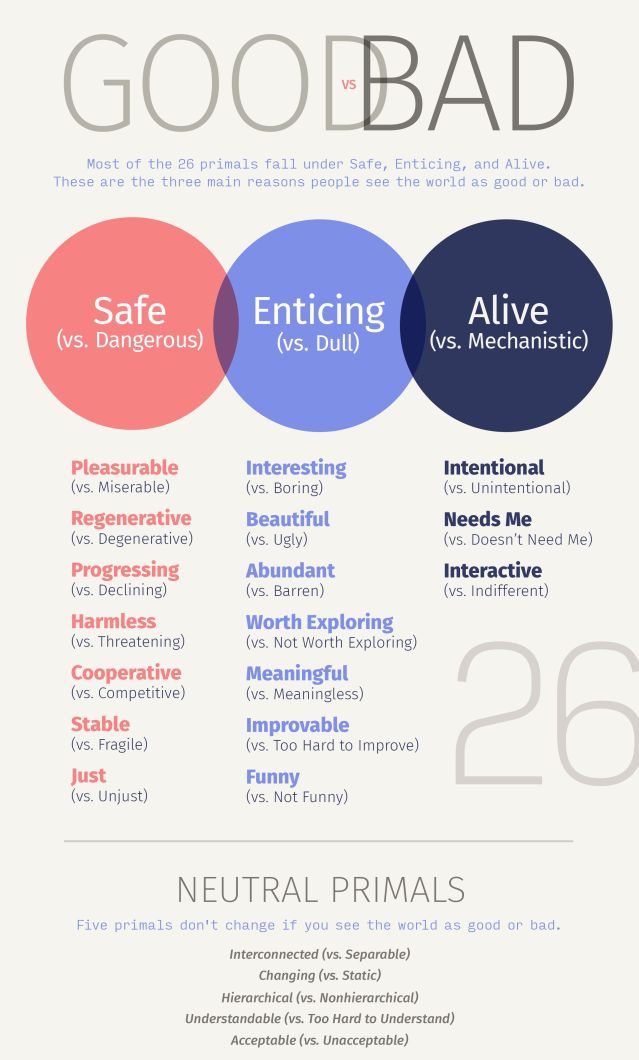Pay Attention to What You Pay Attention To. Primal world beliefs may change what you notice. Reviewed by Tyler Woods

This article was guest-written by Rive Cadwallader. Rive is a Project Manager at the University of Pennsylvania.
From the first moment of each day, we are inundated with information: the sound of birds or traffic outside the window, an accumulation of notifications on our phone, the temperature of the room, a dust bunny under the dresser. It’s estimated that a person sees up to 10,000 advertisements in a single day. Even in a peaceful park, we’re awash with sensory information—way more than we can consciously process.

Fortunately, we have lots of mental tricks to sift out what matters. One of them is the set of beliefs we hold about the situations we are in. Are we in an environment that is harmless? Interesting? Unjust? One situation in particular is often overlooked because it’s a space we never leave: the world.
Primal world beliefs, or "primals," are a person’s basic beliefs about the character of the world itself. These beliefs have been proposed as important influences on personality and behavior, as they perfuse practically every situation a person encounters. Among the 26 empirically-identified primals, the most important are the beliefs that the world is safe (vs. dangerous), enticing (vs. dull) and alive (vs. mechanistic).

Primals are sometimes likened to lenses through which we view the world and they seem to guide our interpretation of ambiguity. Recent studies have found that people who score higher in the belief that the world is threatening are more likely to interpret neutral faces as untrustworthy, unhappy or cold. In other studies, individuals scoring high in dangerous world belief were more likely to implicitly rely on ethnic stereotypes in a dark (rather than bright) room, suggesting that people engage their primals more as ambiguity increases.

This means that in the same ambiguous circumstance, people with different primals might notice totally different things. Imagine that a train full of people slows and stops in the middle of the track. A passenger who thinks the world is safe might notice a toolkit along the tracks and suppose that the train has paused for routine maintenance; a passenger who thinks the world is dangerous might catch an odd sound from the engine and fear the worst. One who thinks the world is ugly might observe the hideous the color of the seats; one who thinks it’s beautiful might appreciate a nice view from the window. Someone who thinks the world is boring might bemoan the poor cell signal, since now they really have nothing to do; someone who thinks the world is interesting might see their neighbor reading a favorite author, and strike up a conversation.
This suggests that primals could be a useful tool for changing what we notice, and therefore how we experience the world around us. Here are three practical suggestions for analyzing and adjusting the lenses through which you view the world:
- Learn about the world beliefs you already have using this free online survey. We recommend the full 99-question version, which will measure each of your primal world beliefs, but if you’re pressed for time there are shorter versions that measure select primals. At the end of each survey, you’ll receive a report explaining your scores and how you compare to other survey-takers.
- Pay attention to what you pay attention to. Based on what you learned about your primals, are you able to identify any patterns in what you perceive about your surroundings? For example, if you think the world is really funny, are you often the first person to notice something silly or amusing around you? If you believe the world is a threatening place, do you tend to spot quite a few people that seem a bit menacing?
- If you’re interested in changing certain primals, try retraining yourself to notice qualities in the world around you that you often overlook. Here’s a great option: take a photo of something each day that you feel illustrates a primal that you want to adopt. There's a photo competition hosted by SeeingHappy that encourages participants to do just that.
All of us live in a positive feedback loop that we can choose to acknowledge and shape, or ignore. In short, the more we notice good things around us, the more we believe that the world is a pretty good place; the more we believe it’s a good place, the more we appreciate the wonderful things right under our nose.
- Questions and Answers
- Opinion
- Motivational and Inspiring Story
- Technology
- Live and Let live
- Focus
- Geopolitics
- Military-Arms/Equipment
- Sicherheit
- Economy
- Beasts of Nations
- Machine Tools-The “Mother Industry”
- Art
- Causes
- Crafts
- Dance
- Drinks
- Film/Movie
- Fitness
- Food
- Spiele
- Gardening
- Health
- Startseite
- Literature
- Music
- Networking
- Andere
- Party
- Religion
- Shopping
- Sports
- Theater
- Health and Wellness
- News
- Culture

